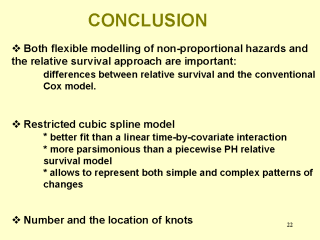 |
This work suggested that both flexible modelling of
non-proportional hazards and the relative survival approach are important. In particular,
there are considerable differences between the results obtained from modelling
non-proportionality of hazards in relative survival and in the conventional Cox model. The
application to colon-cancer data also demonstrated the advantages of using restricted
cubic spline functions for modelling non-proportional hazards in relative survival
analysis. First, the restricted cubic spline model provided a better fit than the model
with a linear time-by-covariate interaction. Moreover, the model based on restricted cubic
spline functions is more parsimonious than a piecewise PH relative survival model and
allows to represent both simple and complex patterns of changes with a single parsimonious
model without requiring a priori definition of the functional form of the variation of the
hazard ratio. Of course using a spline function requires the determination of the the
number and the location of the knots .
 |
Go to Comment Form |
|